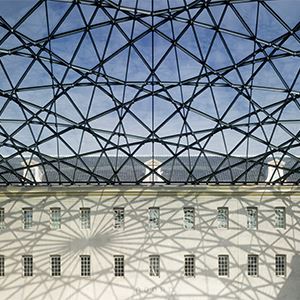
01. Open Courtyard: The Arsenal
The National Maritime Museum’s spectacular building has been associated with shipping and the Dutch navy for a long time. It was built in 1656 as the arsenal – or naval storehouse - of the Admiralty of Amsterdam, where ships’ materials such as sails, ropes, and anchors were kept, as well as cannons and other weaponry for the Dutch warships. The cellars below the courtyard could store 40,000 litres of rainwater. That water was taken on board the warships in barrels for use as drinking water. You can still use one of the two water pumps in the corners of the courtyard today. This huge building was constructed on a newly created island in the port of Amsterdam, resting on no fewer than 2,300 wooden pilings that were brought over from Norway. in 1972 the arsenal became a museum. The National Maritime Museum and its collection couldn’t have wished for a better location than this building full of maritime history, located in the heart of the old port. Between 2007 and 2011, the museum underwent major renovations. These included roofing over this historic courtyard. The design drew inspiration from the compass rose lines found on old nautical maps. The roof is a tour de force in technical terms: the self-supporting structure of steel and glass is 34 metres square and weighs no less than 200 tons. There are 4 LED bulbs embedded at each of the 826 intersections that can be combined to produce all the colours of the rainbow. The roof effectively floats above the courtyard, leaving it still connected to the air outside. The floor of the courtyard was developed specially for the museum to dampen the sound of echoes. Small cracks in the flooring literally drain away the sound waves, reducing the reverberation time from 11 to just 2 seconds.
If you would like to hear more about the glass roof covering the courtyard, press A.


The National Maritime Museum
Het Scheepvaartmuseum (The National Maritime Museum) shows the strong connection between the maritime world and society as a whole, and more specifically the impact of this on the lives of many individuals. The collection of The National Maritime Museum is one of the largest and most notable maritime collections in the world with approximately 400,000 objects, including paintings, models of ships, navigation instruments, and maps of the world. Discover 500 years of Dutch Maritime history as well as its strong links to today’s society and the society of the future.
- Kattenburgerplein 1
- Amsterdam Netherlands
- (020) 52 32 222
- www.hetscheepvaartmuseum.nl
